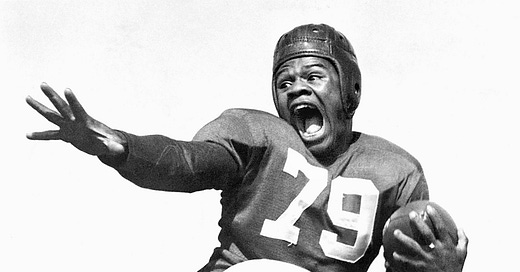Indy Film Fest -- The B1G Story: George Taliaferro
An excellent documentary about a Hoosier of excellence, whether he was breaking barriers on the football field, in society or mentoring the next generation of IU students.
For Indy Film Fest showtimes and tickets, please click here.
You surely know the names of Jackie Robinson and Jesse Owens, icons of sports who helped move not just games but the whole of society toward racial equality. But I’m guessing you don’t know about George Taliaferro — don’t feel bad, I didn’t either. The first Black person drafted into the NFL, he deserves his place in the hall of greats alongside them, and an excellent new documentary about him helps balance the scales just a bit.
Produced and directed by Indiana University faculty and alumnae, “The B1G Story: George Taliaferro” is a gripping look at a man who pursued greatness all his life, first as a football player for IU and the NFL, as someone who helped integrate the campus and later as a mentor to subsequent generations of students and athletes.
Directed by Kevin Weaver and Tucker Gragg, the documentary uses a variety of archival footage, contemporary interviews, animation and extensive testimony from Taliaferro himself, who died in 2018. His statue now looms over the section of the IU campus named after him.
Taliaferro’s family moved to Gary as part of the great Black migration from the South to pursue factory jobs, and he was raised in a poor but integrated neighborhood. He recalls the local kids pitching in together to gather scrap they could sell so they could buy a single football, which he practiced with for hours on end.
After a standout high school career, including his all-Black team defeating a powerhouse white team from East Chicago, Taliaferro was given a scholarship to play at IU. Despite standing an unimposing 5’11” and 196 pounds, he played seven different positions during his college career, from quarterback to running back and receiver.
Taliaferro led the team his freshman year to an undefeated season (with one tie), the only Big Ten championship team to do so. There were a number of veterans on that team — not just upperclassmen, but veterans of World War II who returned to school for the 1945 season.
But Taliaferro was not allowed into the restaurant in Bloomington for the celebration and team photograph because of the color of his skin. In fact, Blacks were not allowed in any of the dorms or cafeterias on campus due to racial discrimination. They would have to rush across town between classes to get home for a bite to eat.
Rather than get mad about it, he did something.
Taliaferro appealed to the university president at the time and got him to demand a privately owned restaurant let him eat there, or he would ban all IU students from going there. Taliaferro personally led other integration efforts, which surprisingly succeeded with little fuss. He even pried a “Colored” sign off the wall of one establishment, which he still carries around with him.
Drafted by the Chicago Bears — his dream since boyhood — Taliaferro instead stuck to his word to play for the Los Angeles Dons of the NFL rival American Football Conference. The leagues eventually merged, and Taliaferro played professional ball for five years before a knee injury cut short his career.
Despite his fame, appearing on national magazine covers and the like, Taliaferro found it difficult to find a job in the still-segregated society of the 1950s. He eventually earned his master’s degree and worked in administration at Morgan State University before being enlisted to return to his alma mater IU in 1972 as a special assistant to the president.
Taliaferro became an IU fixture a secon time around, known for mentoring not just student-athletes but young adults of every creed and background. Several of them talk about what an influence he was on their lives, including convincing them to continue playing when they wanted to quit.
Among those we hear from are professor Gary Sailes, biographer Dawn Knight, Bloomington Herald-Tribune journalist Bob Hammel, basketball great Quinn Buckner, his wife, Viola, daughter Linda Harvey and other members of the Taliaferro clan.
The portrait that emerges from this engaging documentary is of a man who was determined and proud, and fought every step of his life for what he believed in. At first, that was achievement on the sports field. But he also knew when, and how, to stand up for what was right at a time when most of American was still asleep on issues of racism.
George Taliaferro may be a silent giant in the annals of sports, but the great thing about history is that it’s always being written. Here’s a terrific and important new chapter.





